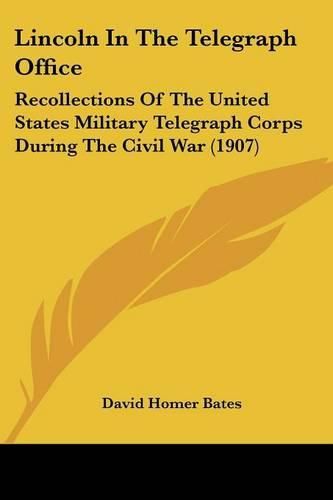Readings Newsletter
Become a Readings Member to make your shopping experience even easier.
Sign in or sign up for free!
You’re not far away from qualifying for FREE standard shipping within Australia
You’ve qualified for FREE standard shipping within Australia
The cart is loading…






As the Civil War raged, President Abraham Lincoln spent many hours in the War Department’s telegraph office, where he received all his telegrams. Morning, noon, and night Lincoln would visit the small office to receive the latest news from the armies at the front. The place was a refuge for the president, who waited for incoming dispatches and talked while they were being deciphered. David Homer Bates, one of the first military telegraphers, recollects those presidential visits during times of crisis. Lincoln in the Telegraph Office, originally published in 1907, shows history in the making and personalities at their most unguarded: Lincoln, Secretary of War Edwin Stanton, Andrew Carnegie, General George McClellan, and many others. The reader is with Lincoln at the scene of dramatic tidings: of the Northern disasters at Bull Run, of Meade’s victory at Gettysburg, of Grant’s capture of Richmond. Lincoln wrote the first draft of the Emancipation Proclamation at the telegraph office, and from there the news of his assassination was relayed. Wartime human-interest anecdotes, the wonder of the new technology, the unraveling of ciphers and codes, conspiracies and rumors, a heightened sense of onrushing events, the tragedy of Good Friday 1865-all are conveyed in this classic of Lincolniana. Introducing Lincoln in the Telegraph Office is James A. Rawley, Carl Adolph Happold Professor Emeritus of history at the University of Nebraska-Lincoln. His works include Turning Points of the Civil War, also available as a Bison Book.
$9.00 standard shipping within Australia
FREE standard shipping within Australia for orders over $100.00
Express & International shipping calculated at checkout
As the Civil War raged, President Abraham Lincoln spent many hours in the War Department’s telegraph office, where he received all his telegrams. Morning, noon, and night Lincoln would visit the small office to receive the latest news from the armies at the front. The place was a refuge for the president, who waited for incoming dispatches and talked while they were being deciphered. David Homer Bates, one of the first military telegraphers, recollects those presidential visits during times of crisis. Lincoln in the Telegraph Office, originally published in 1907, shows history in the making and personalities at their most unguarded: Lincoln, Secretary of War Edwin Stanton, Andrew Carnegie, General George McClellan, and many others. The reader is with Lincoln at the scene of dramatic tidings: of the Northern disasters at Bull Run, of Meade’s victory at Gettysburg, of Grant’s capture of Richmond. Lincoln wrote the first draft of the Emancipation Proclamation at the telegraph office, and from there the news of his assassination was relayed. Wartime human-interest anecdotes, the wonder of the new technology, the unraveling of ciphers and codes, conspiracies and rumors, a heightened sense of onrushing events, the tragedy of Good Friday 1865-all are conveyed in this classic of Lincolniana. Introducing Lincoln in the Telegraph Office is James A. Rawley, Carl Adolph Happold Professor Emeritus of history at the University of Nebraska-Lincoln. His works include Turning Points of the Civil War, also available as a Bison Book.